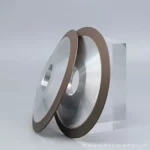What are the characteristics of grinding wheels and how to choose them
A grinding wheel is a precision tool used in various industries for grinding, cutting, and polishing purposes. It consists of abrasive particles bonded together by a matrix material, forming a solid and durable wheel. The characteristics of grinding wheels play a crucial role in determining their suitability for specific applications. In this article, we will discuss the essential characteristics of grinding wheels and provide guidance on how to choose the right one for your needs.
1. Abrasive type: Grinding wheels are available in various abrasive types, including aluminum oxide, silicon carbide, and diamond. Each abrasive type has distinct properties that make it suitable for specific applications. Aluminum oxide is commonly used for general-purpose grinding tasks, while silicon carbide offers better performance for harder materials. Diamond abrasives are the most durable and efficient, suitable for grinding hard materials like carbides and ceramics.
2. Grit size: The grit size of a grinding wheel refers to the size of the abrasive particles embedded in the wheel. It determines the level of surface finish and material removal rate. Smaller grit sizes produce finer finishes but have slower material removal rates, while larger grit sizes offer higher material removal rates but result in rougher surface finishes. The choice of grit size depends on the desired surface finish and the material being worked on.
3. Wheel structure: Grinding wheels can have different structures, which affect their performance and durability. The structure refers to the spacing between the abrasive grains and the bond material that holds them together. Open structures allow for better chip clearance and cooler operation, making them suitable for softer materials. Dense structures, on the other hand, provide better support for the abrasive grains and are ideal for grinding harder materials.
4. Bond type: The bond material in a grinding wheel holds the abrasive grains together and provides the necessary strength and stability. Different bond types, such as vitrified, resin, and metal, offer varying levels of hardness, porosity, and strength. Vitrified bonds are common for general-purpose grinding, resin bonds are suitable for precision grinding, and metal bonds are used for grinding high-strength materials.
5. Wheel shape and size: Grinding wheels come in various shapes and sizes to accommodate different machines and applications. Common wheel shapes include flat, cylindrical, cup, and dish. The choice of wheel shape depends on the specific grinding task and machine requirements. Additionally, selecting the right wheel size is crucial for safety and efficiency. The wheel size should match the machine’s specifications and provide sufficient clearance for the workpiece.
When choosing a grinding wheel, it is essential to consider the specific requirements of your application. Here are some factors to consider:
– Material: Identify the type of material you will be grinding. Different materials require different abrasive types and grit sizes.
– Operation: Determine the type of grinding operation you will be performing, such as surface grinding, cylindrical grinding, or tool grinding. Each operation may have specific wheel requirements.
– Surface finish: Consider the desired surface finish. Finer finishes require smaller grit sizes and different wheel structures.
– Machine compatibility: Ensure that the chosen grinding wheel is compatible with your grinding machine in terms of size, arbor hole diameter, and maximum operating speed.
– Safety: Always prioritize safety. Select a grinding wheel that meets the safety standards and regulations applicable to your industry.
In conclusion, the characteristics of grinding wheels, including abrasive type, grit size, wheel structure, bond type, and wheel shape, greatly impact their suitability for different grinding tasks. Choosing the right grinding wheel involves considering the material being worked on, the desired surface finish, machine compatibility, and safety requirements. By understanding these characteristics and factors, you can make an informed decision and optimize your grinding processes.
.webp)
